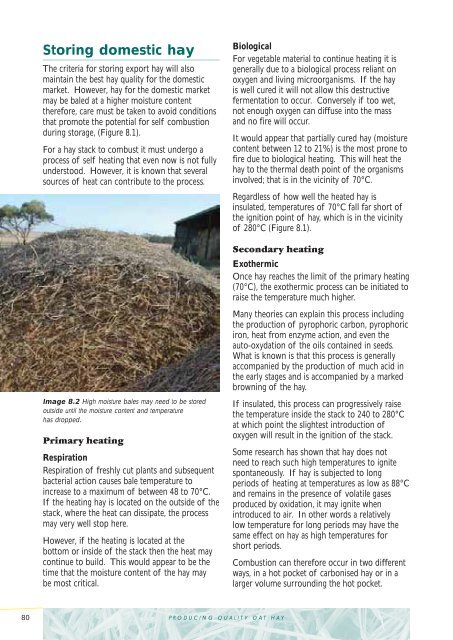Create successful ePaper yourself
Turn your PDF publications into a flip-book with our unique Google optimized e-Paper software.
Storing domestic hay<br />
The criteria for storing export hay will also<br />
maintain the best hay quality for the domestic<br />
market. However, hay for the domestic market<br />
may be baled at a higher moisture content<br />
therefore, care must be taken to avoid conditions<br />
that promote the potential for self combustion<br />
during storage, (Figure 8.1).<br />
For a hay stack to combust it must undergo a<br />
process of self heating that even now is not fully<br />
understood. However, it is known that several<br />
sources of heat can contribute to the process.<br />
Image 8.2 High moisture bales may need to be stored<br />
outside until the moisture content and temperature<br />
has dropped.<br />
Primary heating<br />
Respiration<br />
Respiration of freshly cut plants and subsequent<br />
bacterial action causes bale temperature to<br />
increase to a maximum of between 48 to 70°C.<br />
If the heating hay is located on the outside of the<br />
stack, where the heat can dissipate, the process<br />
may very well stop here.<br />
However, if the heating is located at the<br />
bottom or inside of the stack then the heat may<br />
continue to build. This would appear to be the<br />
time that the moisture content of the hay may<br />
be most critical.<br />
80 PRODUCING QUALITY OAT HAY<br />
Biological<br />
For vegetable material to continue heating it is<br />
generally due to a biological process reliant on<br />
oxygen and living microorganisms. If the hay<br />
is well cured it will not allow this destructive<br />
fermentation to occur. Conversely if too wet,<br />
not enough oxygen can diffuse into the mass<br />
and no fire will occur.<br />
It would appear that partially cured hay (moisture<br />
content between 12 to 21%) is the most prone to<br />
fire due to biological heating. This will heat the<br />
hay to the thermal death point of the organisms<br />
involved; that is in the vicinity of 70°C.<br />
Regardless of how well the heated hay is<br />
insulated, temperatures of 70°C fall far short of<br />
the ignition point of hay, which is in the vicinity<br />
of 280°C (Figure 8.1).<br />
Secondary heating<br />
Exothermic<br />
Once hay reaches the limit of the primary heating<br />
(70°C), the exothermic process can be initiated to<br />
raise the temperature much higher.<br />
Many theories can explain this process including<br />
the production of pyrophoric carbon, pyrophoric<br />
iron, heat from enzyme action, and even the<br />
auto-oxydation of the oils contained in seeds.<br />
What is known is that this process is generally<br />
accompanied by the production of much acid in<br />
the early stages and is accompanied by a marked<br />
browning of the hay.<br />
If insulated, this process can progressively raise<br />
the temperature inside the stack to 240 to 280°C<br />
at which point the slightest introduction of<br />
oxygen will result in the ignition of the stack.<br />
Some research has shown that hay does not<br />
need to reach such high temperatures to ignite<br />
spontaneously. If hay is subjected to long<br />
periods of heating at temperatures as low as 88°C<br />
and remains in the presence of volatile gases<br />
produced by oxidation, it may ignite when<br />
introduced to air. In other words a relatively<br />
low temperature for long periods may have the<br />
same effect on hay as high temperatures for<br />
short periods.<br />
Combustion can therefore occur in two different<br />
ways, in a hot pocket of carbonised hay or in a<br />
larger volume surrounding the hot pocket.

















